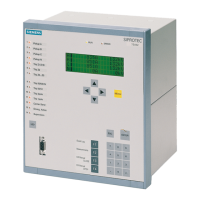Functions
2.10 Automatic Reclosure Function (optional)
SIPROTEC, 7SD610, Manual
C53000-G1176-C145-6, Release date 02.2011
145
1st Reclose Cycle
If working on a line with adaptive dead time, no further parameters are needed for the individual reclose cycles
in this case. All the following parameters assigned to the individual cycles are then superfluous and inaccessi-
ble.
Address 3450 1.AR: START is only available if the automatic reclosure is configured with action time in the
operating mode, i. e. if during configuration of the protection functions (see Section 2.1.1.2) address 134 AR
control mode = Pickup w/ Tact or Trip w/ Tact was set (the first setting only applies to 3-pole trip-
ping). It determines whether automatic reclosure should be started at all with the first cycle. This address is
included mainly due to the uniformity of the parameters for every reclosure attempt and is set to YES for the
first cycle. If several cycles are performed, you can (at AR control mode = Pickup ...) set this parameter
and different action times to control the effectiveness of the individual cycles. Notes and examples are listed in
Section 2.10 at margin heading „Action times“.
The action time 1.AR: T-ACTION (address 3451) is started after a protection function has triggered the au-
tomatic reclosing function. The trip command must occur during this time. If no trip command is issued until the
action time has expired, reclosing will not be initiated. Depending on the configuration of the protection func-
tions, the action time may also be omitted; this applies especially when an initiating protection function has no
fault detection signal.
Depending on the configured operating mode of the automatic reclosure (address 134 AR control mode)
only address 3456 and 3457 (if AR control mode = with TRIP...) are available or address 3453 to 3455
(if AR control mode = with PICKUP ...).
In AR control mode = with TRIP ... you can set different dead times for 1-pole and 3-pole reclose cycles.
Whether 1-pole or 3-pole tripping is triggered depends solely on the initiating protection functions. 1-pole trip-
ping is of course only possible if the device and the corresponding protection function are also capable of 1-
pole tripping:
Table 2-5 AR control mode = with TRIP...
If you only want to allow a 1-pole reclose cycle, set the dead time for 3-pole tripping to ∞. If you only want to
allow a 3-pole reclose cycle, set the dead time for 1-pole tripping to ∞, the protection then trips 3-pole for each
fault type.
The dead time after 1-pole tripping (if set) 1.AR Tdead1Trip (address 3456) should be long enough for the
short-circuit arc to be extinguished and the surrounding air to be de-ionized so that the reclosure promises to
be successful. The longer the line, the longer is this time due to the charging of the conductor capacitances.
Usual values are 0.9 s to 1.5 s.
For three-pole tripping (address 3457 1.AR Tdead3Trip) the network stability is the main concern. Since the
de-energized line cannot transfer synchronizing energy, only short dead times are allowed. The usual values
are 0.3 s to 0.6 s. If the device is operating with a synchronism check device, a longer dead time may be toler-
ated under certain circumstances. Longer three-pole dead times are also possible in radial networks.
For AR control mode = with PICKUP ... it is possible to make the dead times dependent on the type of
fault detected by the initiating protection function(s).
Table 2-6 AR control mode = with PICKUP ...
If the dead time is to be the same for all fault types, set all three parameters the same. Note that these settings
only cause different dead times for different pickups. The tripping can only be 3-pole.
3456 1.AR Tdead1Trip is the dead time after 1-pole tripping,
3457 1.AR Tdead3Trip is the dead time after 3-pole tripping.
3453 1.AR Tdead 1Flt is the dead time after 1-phase pickup,
3454 1.AR Tdead 2Flt is the dead time after 2-phase pickup,
3455 1.AR Tdead 3Flt is the dead time after 3-phase pickup.

